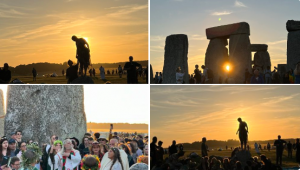In the Northern Hemisphere, the summer solstice is the longest day of the year, or the day with the longest period of daylight. This year’s astronomical event produced by Earth’s tilt on its axis has a date, time, and other relevant facts.
The summer solstice, also known as the June solstice, is the official start of the summer season in the Northern Hemisphere and the winter season in the Southern Hemisphere, according to the National Aeronautics and Space Administration. This astronomical event occurs on June 20 at 10:32 p.m. CDT (UTC-5) for those in North America, and on June 21, 2021, at 03:32 UTC for the rest of the world.
For the uninitiated, June or summer solstice is the longest day of the year in the Northern Hemisphere or the day with the longest period of daylight, but it signals the beginning of winter in the Southern Hemisphere and is the shortest day. The June solstice, which is caused by Earth’s tilt on its axis and travel in orbit around the Sun, will occur this year on Tuesday, June 21, 2022, at 9:14 UTC (4:14 a.m. CDT).

What is the summer solstice, and how is it observed all across the world?
The Summer Solstice is here! But what is it all about, and how do people around the world celebrate the solstice? The event celebrates the astrological start of summer and the longest day of the year. The summer solstice occurs in the northern hemisphere between The word “solstice” comes from the Latin words “sol” which means sun and “sistere” which means immobile or stand still. It happens twice a year, once in the Northern Hemisphere (between June 20-22, depending on the year and time zone) and once in the Southern Hemisphere (between June 20-22, depending on the year and time zone) (between Dec 20-23).
1. Ancient cultures understood that the sun’s passage through the sky, the length of daylight, and the location of sunrise and sunset all shifted in a predictable pattern throughout the year. People also constructed monuments, such as Stonehenge in England, to track the sun’s annual travel, worship it, and anticipate its movements.
2. During the June solstice, the north pole is tipped more directly toward the sun than at any other time of the year, and the south pole is turned more directly away from the sun. As a result, all sites north of the equator have days that are longer than 12 hours, while all locations south experience days that are shorter.
3. The June solstice occurred a few thousand years ago when the sun was in the constellation of Cancer (Latin for crab), which is how the line of latitude, Tropic of Cancer, was named. On the June solstice, the sun reaches its northernmost position, reaches the Tropic of Cancer, and stands still before reversing direction and moving south again.
4. On the summer solstice, the sun’s path across the sky is curved, not straight.
5. On the day of the summer solstice, the sun rises farthest left on the horizon and sets at its rightmost possible location, illuminating spots in your home that are illuminated at no other time.
6. The summer solstice date varies between June 20, 21, and 22 based on Earth’s current orbit and is not fixed because it is determined by the mechanics of our solar system rather than the human calendar.
7. The summer solstice is also known as Midsummer or the First Day of Summer, while Wiccans and other Neopagan groups refer to it as Litha, and some Christian churches observe it as St John’s Day to celebrate John the Baptist’s birth.
8. The Vikings are supposed to have hung dead human and animal bodies from trees as a tribute to the gods, especially around the solstice.
9. People used to wear protective garlands of herbs and flowers like “chasing devil,” which is now known as St John’s Wort, to fend off bad spirits who were said to come on the summer solstice, according to pagan tradition.
10. Iceland is the only spot outside of the Arctic Circle where we may see the sun “not set,” as seen from the top of a cliff overlooking the sea in northern Iceland, where the light dips all the way down to the horizon, brushes the water, and then rises again.